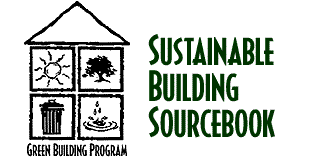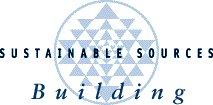
|

|

|
Looking for a Workshop or Conference?See the Sustainable Building Calendar! |
DEFINITION
An energy recovery ventilator (ERV) is a type of mechanical equipment that features a heat exchanger combined with a ventilation system for providing controlled ventilation into a building.
An energy recovery ventilator with humidity regulation incorporates a method to remove excess humidity or add humidity to the ventilating air that is being brought into a house.
CONSIDERATIONS
This type of equipment was introduced as "air-to-air" heat exchangers in the colder regions of the U.S., Canada, Europe, and Scandinavia over 10 years ago. In these areas, tightly-built modern houses were developing problems with indoor air quality and excessive humidity during the winter. The air-to-air heat exchanger brought in fresh outside air to combat these problems, and preheated it at the same time. These products are now called heat recovery ventilators or HRVs.
Generally, in the Austin climate, there is not a significant energy dollar savings from using this type of equipment since they are quite costly (approximately $1,000 plus installation). The winters are too mild and short and the units are not as effective in the cooling season. However, when the health value of having fresh air in a home is considered, this equipment can be worth considering, particularly if it's the type that also controls humidity.
If a house is constructed tighter than 0.5 air changes per hour, any pollutants generated in the home can accumulate and reduce the indoor air quality to unhealthful levels. If fresh outside air is brought in through an open window to alleviate this problem, this air may be excessively hot, cold or humidity-laden and require conditioning at added expense.
In the Austin region, cooling energy costs can exceed heating energy costs. Therefore, it is more appropriate to consider this equipment useful in recovering "energy" (energy recovery ventilator) not simply "heat" (heat recovery ventilator).
| Commercial Status |
Implementation Issues |
||||||
|---|---|---|---|---|---|---|---|
| ERV | |||||||
| ERV With Humidity Regulation | |||||||
| Legend | |
|---|---|
| Satisfactory |
|
| Satisfactory in most conditions |
|
| Satisfactory in Limited Conditions |
|
| Unsatisfactory or Difficult |
|
Heating and/or cooking equipment and/or the attached garage are not adequately vented.
Household chemicals are stored in the house.
Radon levels are high. (If radon levels are higher than 15 pCi/liter [picoCuries per liter], an ERV will not be adequate to remedy the situation. Four picoCuries per liter is the level at which the EPA recommends that remedial action take place.) In the Austin region, radon is generally not considered a problem.
Formaldehyde levels are high.
The home becomes depressurized as a result of leaks in the home's mechanical system. This is a common problem.
Counter flow flat-plate cores
Heat pipe core
Rotary wheel core. (These exchangers offer the best advantages for
homes with air conditioning as they can regulate humidity with a
rotary wheel core plus a desiccant wheel.)
In the winter, the outgoing heated stale air will pre-heat the incoming fresh air to some extent, according to the unit's efficiency. The opposite occurs in the summer with the outgoing air pre-cooling the incoming air.
A unit with humidity regulation will remove humidity from humid summer fresh air and add humidity to the incoming dry winter air.
The Home Ventilating Institute (HVI) has a standard test for units manufactured in the United States. Not all manufacturers have been tested, so it is necessary to examine efficiency claims to see if they are HVI data or manufacturers data to get a true comparison. All units sold in Canada are subject to a standard test (R-2000), which is almost identical to HVI's test.
They require two connections to the outdoors - one to exhaust the stale indoor air and the other to bring in the fresh outside air. The inlet and outlet on the building exterior need to be distanced from each other to avoid cross contamination. It is preferred to have the inlet and outlet on different sides of the house.
Fresh air from the unit into the home's interior can be supplied in two ways. A separate supply duct can carry the fresh air to a central location in the house. This supply outlet is best located where the air will not blow on people, since the air can be too cool or too warm depending on the season. The fresh air can also be placed into the existing ductwork, typically, in the return duct.
The stale air from a home is typically drawn from the most humid locations - bathroom(s) and kitchen. An ERV works with bathroom exhaust fans by continually drawing air from the bathroom. When the bathroom is in use, the exhaust fan boosts the exiting of humid air into the same duct used by the ERV. However, an ERV should not share the same exhaust duct as a range hood.
Des Champs Laboratories, Inc.
(E-Z-Vent, has counterflow core)
Stirling Technology, Inc. (RecoupAerator(TM), has rotary core)
Amerix Corporation
(EMX, has cross-flow core)
Desiccant Technology Inc.
(D-Tech, has rotary core)
Nutech Energy Systems, Inc. (Lifebreath(TM), has cross flow core)
Bossaire Inc.
(Bossaire BX-125, has cross-flow core)
Venmar Ventilation (Flair, has cross flow and counter flow core)
Honeywell Inc. (Energy Recovery Ventilator, has rotary core and desiccant moisture control)
Home Ventilating Institute (HVI)
Energy Source Directory
return to
Sourcebook Contents |
Search Sustainable Sources |
Green Building Conferences |
Bookstore |
Sustainable Building Calendar |
Green Building Professionals Directory
This file last updated on Tuesday, August 20, 2002
FINANCING:
This equipment can easily tie into the HVAC system of a home. It enhances the quality of the home environment. This should not be a problem for lenders. It is unknown if appraisers will give additional value for this equipment.PUBLIC ACCEPTANCE:
There is very little awareness of this type of equipment. When understood, it is generally regarded favorably by people interested in new energy efficient homes and indoor air quality.REGULATORY:
None.
ERVs are available in wall mount or duct-connected models. This discussion will focus on duct connected models which can be used for ventilating an entire house.
GUIDELINES1.0 Best Applications for an ERV
The house is very tight - 0.5 air changes per hour (ACH) or less.
2.0 Types of Heat Exchanger Cores
Cross flow plate cores
3.0 Efficiency
The efficiency of ERVs refers to the amount of temperature adjustment of the incoming fresh air that the outgoing stale air can accomplish in the heat exchanger.
4.0 Installation
These units are typically installed in an attic, crawlspace, or storage/utility area.
RESOURCES
PROFESSIONAL ASSISTANCE
See "Engineers -Professional" in Yellow Pages
COMPONENTS / MATERIALS / SYSTEMS
Conservation Energy Systems, Inc. (vanEE, has cross flow core)
2525 Wentz Ave.
Saskatoon, Saskatchewan, Canada S7K 2K9
(800) 667-3717
Box 220
Natural Bridge Station, VA 024579
(703) 291-1111
P.O. Box 2633
Athens, OH 45701
(800) 535-3448
2796 5th Ave, S.
Fargo, ND 58103
(800) 232-4116
8 Cayuga Way
Basking Ridge, NJ 07920
(908) 604-9619
511 McCormick Blvd.
London, Ontario, Canada N5W 4C8
(519) 457-1904
2901 SE 4th St.
Minneapolis, MN 55414
(612) 378-0049
1715 Haggerty St.
Drummondville, Quebec, Canada J2C 5P7
(819) 477-6226
2701 4th Ave. S
Mpls, MN 55408
(800) 328-5111
Energy Federation Inc. (VanEE Duo model includes dessicant wheel)
14 Tech Circle
Natick, MA 01760-1086
(800) 876-0660
GENERAL ASSISTANCE
American Society of Heating, Refrigeration, Air Conditioning Engineers (ASHRAE)
1791 Tullie Circle NE
Atlanta, GA 30329
(404) 636-8400
30 W. University Drive
Arlington Heights, IL 60004-1893
(708) 394-0150
Iris Communications, Inc.
258 East 10th Ave., Suite E
Eugene, OR 97401-3284
(503) 484-9353




Water
Energy
Building
MaterialsSolid Waste



![]()
Sustainable Building Sourcebook web version copyright Sustainable Sources 1994-2000.